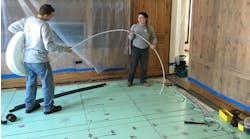LEAD, S.D. — An historic opera house here is back in business after it was retrofit with an electric radiant floor heating system. Completed in 1914, the opera house endured two major fires. The local non-profit that’s been working for several years to restore the structure still needs to raise plenty of money, but the old theater is warm and events are being staged.
Lead was a mining town. The Homestake Opera House and Recreation Building, which included a swimming pool, a library and a bowling alley along with the auditorium, was a gift from the Homestake mining company to the town. The project was the brainchild of Phoebe Apperson Hearst, who enlisted the help of the Homestake Mine’s superintendent to get the structure built. After the structure was completed, it hosted concerts, silent movies and traveling road shows.
Restoring a huge shell of a masonry building is a daunting task for a non-profit, let alone one from a town of approximately 3,800 people.
It would have been historically accurate to heat the building hydronically, although not with a coal-fired boiler that was the original.
Bids for a boiler system, however, came in at $750,000 and it would have cost $5,000 a month to fire the boiler, said Jim O’Grady, past executive director of The Historic Homestake Opera House Society.
Tim Verhulst of Warm Floor Designs, Spearfish, S.D., did the job with electric radiant mats supplied by Step Warmfloor for $100,000. Once the structure was useable, Verhulst said, the Society would heat it for events with portable propane heaters. The cost of heating the building for an entire month with electric radiant was only $200 more than the cost of propane for one day, Verhulst said.
“We put down about 6,000-sq.ft. of electric radiant mat,” Verhulst said.
Stefan and Monika Irgens, the two owners of Step Warmfloor, came to Lead from St. Louis to help design and supervise the job. After that, Verhulst and three of his men took six weeks to install the radiant mat. Plywood was placed on top of the mat and then linoleum was installed on top of the plywood, which is what was in the building originally. The mat layout had to accommodate the chairs.
“We avoided the seat brackets with the radiant mats because a lag bolt and a metal chair would be a complete circuit,” Verhulst noted.
A big part of the heating problem for the building was the ceiling height of the auditorium, said Monica Irgens. She noted that radiant heat had also been added to the stage and the balcony.
When the Irgens arrived in Lead, they had to develop a final design on-site. The layout had to avoid the rows of seats, plus an auditorium is curved and the mats had to work around that.
The crew marked off the floor areas where the benches would go and then two strips of Warmfloor mat were installed in between rows. Because the mat can be cut in the field, the crew was able to change the layout on the fly. After the plywood and linoleum was installed, the mat, obviously, could not be seen. The crew installing the benches shot the floor with a Flir thermal imaging camera to locate the mats.
“The job went really well. We’re very, very satisfied,” O’Grady said. “The first winter we had that installed, it did a really good job of warming the place up and has a low cost to operate.”
O’Grady estimated first-year savings over a gas-fired boiler system of $400,000, which is critical for a small non-profit that’s still looking to raise nearly $4 million to finish the building.
Related Articles:
Country-French home utilizes energy-efficient systems




